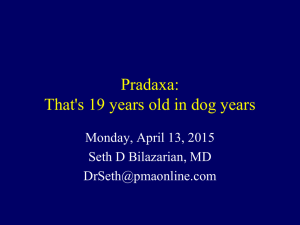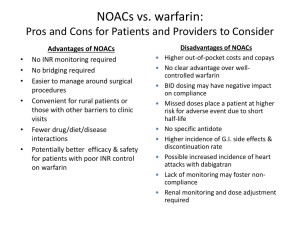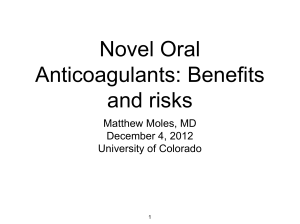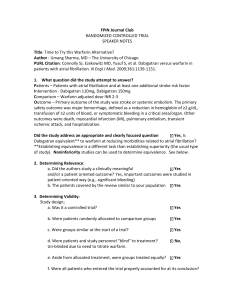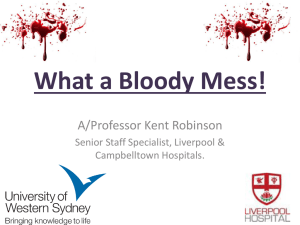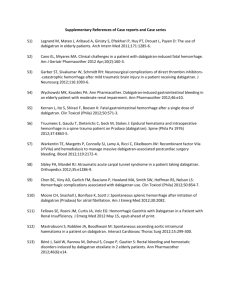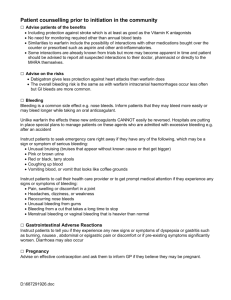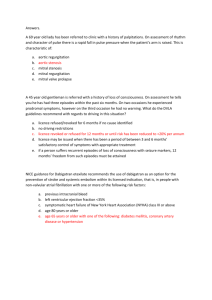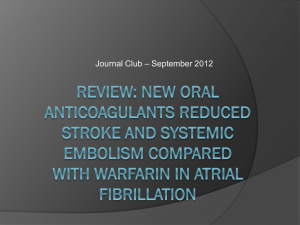Management Review Meeting 2011 - Cardiologie
advertisement
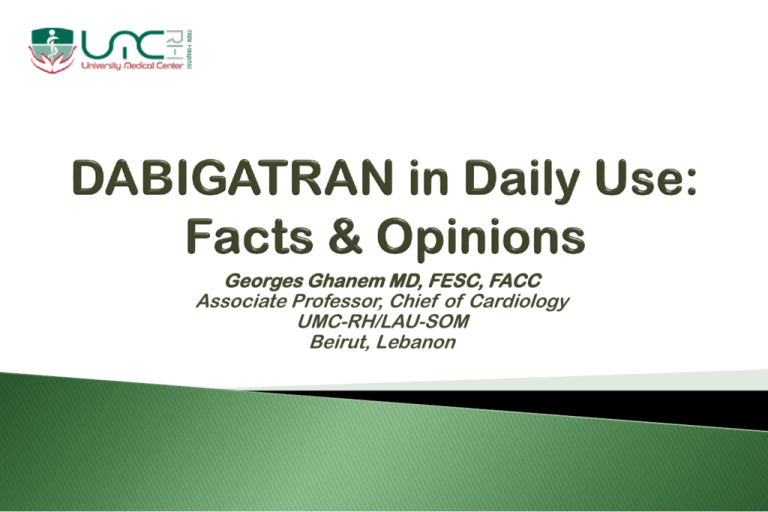
Georges Ghanem MD, FESC, FACC Associate Professor, Chief of Cardiology UMC-RH/LAU-SOM Beirut, Lebanon Dabigatran is the first new oral anticoagulant to become available for clinical use in >50 years. THE RE-LY® STUDY: RANDOMIZED EVALUATION OF LONG-TERM ANTICOAGULANT THERAPY Dabigatran compared with warfarin in 18,113 patients with atrial fibrillation at risk of stroke Dabigatran etexilate is not approved for clinical use in stroke prevention in atrial fibrillation outside the US and Canada Connolly SJ, et al. N Engl J Med 2009;361:1139-1151. RATE OF STROKE OR SSE RR 0.65 (95% CI: 0.52–0.81) P<0.001 (superiority) RRR 35% Rate per year (%) 1.8 RR 0.90 (95% CI: 0.74–1.10) P<0.001 (non-inferiority) 1.5 1.2 1.54 1.71 0.9 0.6 1.11 0.3 0 Events/n: D150 mg BID D110 mg BID Warfarin 134 / 6,076 183 / 6,015 202 / 6,022 D = dabigatran; RR = relative risk; RRR = relative risk reduction; SSE = systemic embolism. Dabigatran etexilate is not approved for clinical use in stroke prevention in atrial fibrillation outside the US and Canada. Connolly SJ, et al. N Engl J Med 2010;363:1875-1876. v2 November 2010 7 Dabigatran 150 mg bid provided superior stroke prevention vs warfarin1,2 35% reduced in risk of stroke or SE vs well-controlled warfarin (INR 2.0−3.0)1,2 ITT data 1. Connolly SJ et al. N Engl J Med 2009; 361:1139–1151. 2. Connolly SJ et al. N Engl J Med 2010; 363:1875–1876 (letter to editor). v2 November 2010 8 HAEMORRHAGIC STROKE RR 0.26 (95% CI: 0.14–0.49) Number of pateitns with event P<0.001 (superiority) RRR 74% RR 0.31 (95% CI: 0.17–0.56) P<0.001 (superiority) 50 RRR 69% 40 45 0.38% 30 20 10 0 12 14 0.10% 0.12% D150 mg BID D110 mg BID Warfarin 6,076 6,015 6,022 D = dabigatran; RR = relative risk; RRR = relative risk reduction. Dabigatran etexilate is not approved for clinical use in stroke prevention in atrial fibrillation outside the US and Canada. Connolly SJ, et al. N Engl J Med 2009;361:1139-1151. v2 November 2010 9 LIFE-THREATENING BLEEDING RATES RR 0.80 (95% CI: 0.66–0.98) P=0.03 (superiority) RRR 20% RR 0.67 (95% CI: 0.54–0.82) P<0.001 (superiority) Rate (% per year) 2.0 RRR 33% 1.5 1.0 1.85 1.49 1.24 0.5 0 Events/n: D150 mg BID D110 mg BID Warfarin 179 / 6,076 147 / 6,015 218 / 6,022 D = dabigatran; RR = relative risk; RRR = relative risk reduction. Dabigatran etexilate is not approved for clinical use in stroke prevention in atrial fibrillation outside the US and Canada. Connolly SJ, et al. N Engl J Med 2010;363:1875-1876. v2 November 2010 10 RE-LY® IN PERSPECTIVE Meta-analysis of ischaemic stroke or systemic embolism Warfarin vs. placebo Warfarin vs. low dose warfarin Warfarin vs. ASA Warfarin vs. ASA + clopidogrel Warfarin vs. ximelagatran Warfarin vs. dabigatran 150 mg BID 0 0.3 0.6 Favours warfarin 0.9 1.2 1.5 1.8 2.1 Favours other treatment ASA = acetylsalicylic acid. Dabigatran etexilate is not approved for clinical use in stroke prevention in atrial fibrillation outside the US and Canada. Camm J. Oral presentation at ESC on 30 Aug 2009 http://www.escardio.org/congresses/esc-2009/webcasts/pages/sunday.aspx v2 November 2010 11 NET CLINICAL BENEFIT AND COMPONENTS P value P value D150 vs. W D110 vs. W 7.91 0.02 0.09 1.71 <0.001(NI) <0.001(NI) <0.001(sup) 0.30(sup) Dabigatran Dabigatran 150 mg 110 mg Number of patients 6,076 6,015 6,022 Net clinical benefit 7.11 7.34 1.11 1.54 Characteristic Stroke or SSE Warfarin Death 3.64 3.75 4.13 0.051 0.13 Major bleeding 3.32 2.87 3.57 0.32 0.003 Pulmonary embolism 0.15 0.12 0.10 0.30 0.71 Myocardial infarction 0.81 0.82 0.64 0.12 0.09 Data represent %/year. D = dabigatran; W = warfarin.; NI = non-inferiority; Sup = superiority; SSE = systemic embolism. Dabigatran etexilate is not approved for clinical use in stroke prevention in atrial fibrillation outside the US and Canada. Connolly SJ, et al. N Engl J Med 2010;363:1875-1876. v2 November 2010 12 Dabigatran 150 mg bid prevents 3 out of 4 AFrelated strokes1 Warfarin prevents 64% of strokes.2 Dabigatran prevents an additional 35% of the remaining strokes or systemic embolisms3,4 1. Roskell NS et al. Thromb Haemost 2011; 102: Epub ahead of print. 2. Hart RG et al. Ann Intern Med 2007; 146:857–867. 3. Connolly SJ et al. N Engl J Med 2009; 361:1139–1151. 4.Connolly SJ et al. N Engl J Med 2010; 363:1875–1876 (letter to editor). v2 November 2010 13 Recommended dosing- Special patient populations Patients 80 yrs or above, dosing should be reduced to 220 mg given as 110 mg BID due to the increased risk of bleeding in this population. Patients with age between 78-80, at the discretion of the physician, when the thromboembolic risk is low and the bleeding risk is high, the lower dose 220mg can be considered. Patients concomitantly used with verapamil, dosing should be reduced to 220 mg BID Patients with increased bleeding risk should be monitored clinically & a dose of 220 mg, may be considered. Dose adjustment at the discretion of physician, following risk/benefit of the individual patient. Special patient populations - potentially at higher risk of bleeding Dabigatran should be used with caution in conditions with an increased risk of bleeding Close clinical surveillance recommended throughout treatment period, especially if risk Factors are combined. Below summarizes factors which may increase the haemorrhagic risk. Pharmacodynamic and kinetic factors Age ≥75 years Factors increasing dabigatran plasma levels Major: Moderate renal impairment (30-50 ml/min CrCL) P-gp inhibitor co-medication Minor: Low body weight (<50 kg) Diseases/procedures with special haemorrhagic risks Congenital or acquired coagulation disorders Thrombocytopenia or functional platelet defects Active ulcerative GI disease Recent GI bleeding Recent biopsy or major trauma Recent ICH Brain, spinal, or ophthalmic surgery Pharmacodynamic interactions ASA NSAID Clopidogrel Updated Contraindications 1. Severe renal impairment (CrCl < 30mL/min) 2. Spontaneous or pharmacological impairment of haemostasis 3. Active clinically significant bleeding or organic lesion at risk of bleeding 4. Hypersensitivity to the active substance or to any of the excipients 5. Concomitant treatment with: ketoconazole, cyclosporine, itraconazole tacrolimus How to switch from other Anticoagulants to Dabigatran? How to switch to Dabigatran from a vitamin K antagonist VKA should be stopped; dabigatran should be given as soon as the patient’s INR is below 2.0 How to switch from injectable anticoagulants to Dabigatran Dabigatran should be given 0-2 hours prior to the time that the next dose of injectable anticoagulant would be due. Switching back to warfarin from Pradaxa If you should decide to stop Pradaxa treatment and switch to warfarin/VKA therapy, renal function needs to be considered (creatinine clearance): For CrCl >50 mL/min, start warfarin 3 days before discontinuing Pradaxa For CrCl 31–50 mL/min, start warfarin 2 days before discontinuing Pradaxa If you should decide to switch to an injectable anticoagulant should be given 12 hours after the last dose of Pradaxa Missed dose If the prescribed dose is not taken at the scheduled time, the dose should be taken as soon as possible on the same day. A missed dose may still be taken up to 6 hours prior to the next scheduled dose. From 6 hours prior to the next scheduled dose on, the missed dose should be omitted. Patients should not take a double dose to make up for missed individual doses. For optimal effect and safety, it is important to take Dabigatran regularly twice a day, at approximately 12 hour intervals. Guidance on surgery and intervention Patients on dabigatran who undergo surgery/invasive procedures are at increased risk of bleeding. In these circumstances a temporary discontinuation of dabigatran is advisable If emergency surgery is required, dabigatran should be temporarily discontinued. A surgery/intervention should be delayed if possible until at least 12 hours after the last dose. If surgery cannot be delayed, the risk of bleeding may be increased. In RE-LY, a total of 1,983 cardioversions were performed in 1,270 patients, with similar numbers in each treatment group (647 in the dabigatran 110mg* group, 672 in the PRADAXA 150mg group and 664 in the warfarin group). Rates of stroke and systemic embolism within 30 days of cardioversion were low and did not differ significantly between treatment arms (0.77%, 0.3% and 0.6%, respectively; dabigatran 110mg vs. warfarin, p=0.71; PRADAXA 150mg vs. warfarin, p=0.45) though the RE-LY trial and this subgroup analysis were not powered to demonstrate statistical significance. Similarly, major bleeding within 30 days of cardioversion was infrequent and comparable between treatment groups (1.7%, 0.6% and 0.6%, respectively). Recommandations in case of bleeding / or cases of overdose Discontinue Dabigatran Investigate the source of bleeding Maintain adequate diuresis before initiation of standard treatments Surgical hemostasis Blood volume replacement (eg, fresh whole blood or fresh frozen plasma) Application of factor concentrates (Please note: while there is some experimental evidence to support the role of these agents, limited clinical evidence is available) Prothrombin complex concentrates (PCC) (eg, non-activated or activated) Recombinant activated factor VIIa (rFVlla) Platelet concentrates may be considered when thrombocytopenia is present or long-acting antiplatelet drugs (eg, Asp or clopidogrel) have been used Eliminate dabigatran via dialysis, constant hemoperfusion Measuring Anticoagulation activity of Dabigatran Dabigatran- No routine monitoring required Monitoring is required for drugs with narrow therapeutic index,as warfarin, warfarin difficult to keep in range as it has variable dose response & subject to numerous interactions with drugs, diet. Dabigatran has a predictable pharmacodynamic profile, is not affected by food, & has low potential for d–d interactions; requires no INR monitoring & no dose adjustment NOTE: INR is very insensitive to the dabigatran treatment and cannot be recommended as a coagulation test. Recommended tests: semi-quantitative Activated Partial Thromboplastin Time test: An aPTT >80 seconds, or approximately 2–3fold prolongation at trough (when the next dose is due) is associated with a higher risk of bleeding An aPTT of approximately 1.5-fold prolongation at trough is the expected level of anticoagulation after the intake of Dabigatran 150 mg bid He noted that: ◦ the main American and European Society of Cardiology (ESC) guidelines have suggested that the new drugs are "alternatives to warfarin," ◦ while new Canadian Guidelines have made the jump to the new agents being "preferred to warfarin." ◦ In England, NICE is encouraging of its use, stating, "Dabigatran is an important development" and "within the range considered costeffective," ◦ while the Scottish Healthcare Improvement agency says, "Warfarin remains the anticoagulant of choice, but dabigatran can be used in patients with poor INR control or those with allergies or intolerance to warfarin." On which dose of dabigatran to use in which patients, Camm pointed out that the FDA chose not to approve the 110-mg dose as it couldn't find a group of patients in whom the net clinical benefit was better on 110 mg than on 150 mg. But he noted that in Asia the 110-mg dose is standard, probably because they are smaller people and have traditionally erred toward a lower anticoagulant status. Dabigatran etexilate was approved by the FDA on October 19, 2010, for marketing in the United States for the prevention of stroke and systemic embolism in patients with nonvalvular AF. A dose of 150 mg twice daily was approved for patients with a creatinine clearance >30 mL/min, whereas in patients with severe renal insufficiency (creatinine clearance 15 to 30 mL/min) the approved dose is 75 mg twice daily, a dose currently marketed in the European Union but not evaluated in the RE-LY trial. There are no dosing recommendations for patients with creatinine clearance <15 mL/min or patients on dialysis. The major problem with stroke prevention in AF is not whether dabigatran 150 mg should be used in preference to 110 mg. The key problem is that too many AF patients who should be treated with anticoagulants are treated with antiplatelet therapy or remain untreated. In an overview of studies since 2000, a median of 52% of AF patients received anticoagulants, 30% received antiplatelet therapy, and 18% were untreated.(7) Intensive educational updates, peer review, and patient advocacy will improve these metrics and should lead to a decrease in stroke incidence. Similar to what we are seeing with the high dose statin and the incidence of Diabetes….. It is now clear that there is a small but definite signal of MI with dabigatran vs warfarin, but this is far outweighed by its benefits. The trend is there. Let's keep an eye open and see!!!
